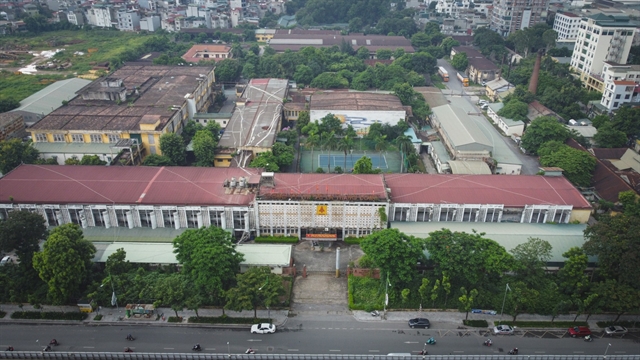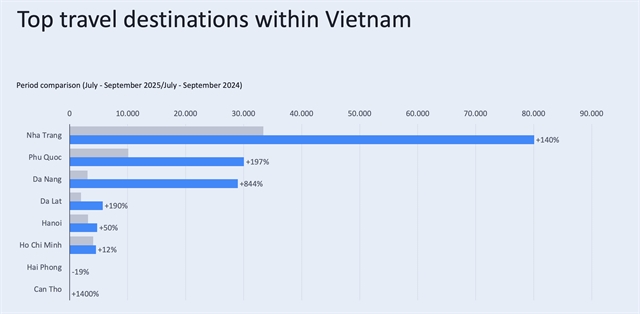 Opinion
Opinion

 |
| People at the Public Administration Service Centre of Nam Định Ward, Ninh Bình Province.— VNA/VNS Photo Nguyễn Lành |
Việt Nam officially implemented a new two-tier local government model on July 1, comprising the provincial level (provinces and centrally-governed cities) and the communal level (communes, wards and townships on the mainland, as well as special administrative zones on offshore islands). The model replaces the previous three-tier structure, which contained provincial, district and communal levels. To mark the important development, Việt Nam News reporter Nguyễn Hằng interviews ambassadors and representatives of diplomatic missions in Việt Nam about their assessments and expectations of the new model.
What is your overall assessment of Việt Nam’s official transition to a two-tier local government system? From your perspective, what practical benefits or improvements do you anticipate the new model could bring to the operations of your mission in Việt Nam?
 |
| British Ambassador Iain Frew. |
British Ambassador Iain Frew: At first glance, Việt Nam’s transition marks a significant step toward rebuilding and reforming local government as a cornerstone of its economic development strategy. Much of the focus is on getting the fundamentals right, establishing a clear, lawful and modern framework that raises standards and improves working practices in the public sector.
While it is still early to see tangible impacts on our mission’s operations during this transition period, I’m confident that the new model will help strengthen the relationship between the central and local government. It will empower local leaders to make decisions that reflect the needs of their communities, support inclusive economic growth and drive public service reform.
Ultimately, where decisions and reforms are made in a more effective and agile way, this should lead to a more attractive business environment for foreign investors, more efficient public administration and better outcomes for citizens. These are key ingredients for the success of our mission in Việt Nam.
Ramla Khalidi, UNDP Resident Representative: It is still early to offer a full assessment, as the new two-tier system only came into effect a few weeks ago, on July 1. However, at UNDP, drawing on over a decade of insights from our Provincial Governance and Public Administration Performance Index (PAPI), we see promising opportunities ahead. The shift is designed to improve efficiency in public administration by streamlining layers of government and bringing service delivery closer to citizens. PAPI data has consistently shown that certain services - such as the issuance of land use rights certificates or construction permits - have not always met public expectations when managed at the district level. A more localised approach has the potential to lead to faster, more responsive services; efficient services that meet the needs and expectations of citizens.
Proximity to communities also allows for better understanding of their diverse needs. PAPI findings show that women, ethnic minorities, internal migrants and rural residents often report less positive experiences with local governance. Strengthening the commune level provides an opportunity to tailor policies to these groups and improve service equity. Moreover, the consolidation of administrative units may free up resources, which can be reallocated to support high-impact governance and development interventions, particularly in areas where gaps remain most acute. It is essential that these resources are targeted to help provinces and communes that have historically faced capacity constraints. UNDP stands ready to work with national and local authorities to help realise the full potential of this reform.
Mette Møglestue, Chargés d'affaires a.i., Norwegian Embassy in Hà Nội: I have followed Việt Nam’s recent transition toward a two-tier government system with both interest and optimism. The ongoing administrative restructuring appears to be an ambitious and comprehensive effort to streamline governance by reducing intermediate layers and building a leaner, more capable and more responsive public administration.
The emphasis on efficiency, effectiveness and efficacy reflects a strong commitment to modernising the state apparatus and improving service delivery. It is encouraging to see that a central objective is to better meet the needs and expectations of citizens. By doing so, the reform may contribute to strengthening public trust and enhancing accountability in governance.
Chief Representative of the Japan International Cooperation Agency (JICA) in Việt Nam Kobayashi Yosuke: I would like to extend my heartfelt congratulations on Việt Nam’s successful transition to a two-tier local government system. I and many Japanese people are truly impressed by drastic reforms that have been launched and realised at miraculous speed in Việt Nam. I would like to first stress that JICA supports and stands ready to help Việt Nam accelerate its comprehensive reform efforts. JICA has been implementing various projects in many provinces and cities in Việt Nam. One of the challenges we face when having cooperation with local governments is the time required for the process of decision-making and administrative procedures that negatively affect the progress of project implementation. I believe the transition to a two-tier local government with the removal of intermediate tier will help accelerate internal consultations process and administrative procedures.
In addition, I understand that the transition to a two-level local government is not just about abolishment of the district-level government, but more importantly, as Party General Secretary Tô Lâm said, Việt Nam is moving forward more delegation of power and tasks to local governments with the principle "local government decides, acts and takes responsibility". Given this direction, I strongly hope local governments will be more decisive, motivated and dynamic and all this will help improve the progress of our JICA projects in the localities.
Could you kindly share your recommendations on how Việt Nam might effectively implement the two-tier local government model?
 |
| Ramla Khalidi, UNDP Resident Representative in Việt Nam.— Photo courtesy of the UNDP in Việt Nam |
Ramla Khalidi, UNDP Resident Representative: We recommend focusing on three key areas. First, ensure that newly expanded communes and provinces, especially those covering large areas in remote and underserved regions, have sufficient financial and human resources to fulfil their mandates. Support to communes is essential, given their significantly enhanced responsibilities. Endowing them with clear mandates and adequate resources is critical.
Second, and this is fundamental, prioritise two-way communication between government, citizens and businesses. As changes unfold rapidly, people must have access to accurate and timely information about how and where to access services. Equally, a feedback loop is key to help quickly identify areas for improvement. Authorities should actively solicit and listen to feedback from communities and the private sector to identify and close implementation gaps.
Third, create the enabling environment that rewards innovation, and encourages new ideas, new ways of working, and responsible and ethical use of digital technologies. Local governments will need to adapt to complex and evolving challenges such as climate change, migration, and an ageing population. This calls for dynamic capabilities, including the use of data, technology and adaptive service models to anticipate needs and deliver inclusive, effective solutions.
It is known that many areas in Britain adopt a two-tier local government model. Could you kindly share Britain’s experience in operating a two-tier local government system effectively?
British Ambassador Iain Frew: The United Kingdom operates a devolved system of government, with distinct models in each of its nations and regions. Scotland, Wales and Northern Ireland each have their own parliaments or assemblies with varying degrees of legislative power over areas such as health, education, and transport. In England, devolution has taken a more localised form, with metro mayors and combined authorities in major city regions like Greater Manchester and the West Midlands, alongside traditional local authorities. These arrangements reflect the UK’s flexible and evolving approach to governance, tailoring powers and responsibilities to local needs while maintaining the integrity of the union.
About the UK experience, like Việt Nam, the UK has been on a journey to modernise and streamline local government. We have recognised that while the two-tier system has served many communities well, there are opportunities to make local governance more efficient, accountable and responsive to citizens’ needs.
In recent years, the UK government has supported a shift toward single-tier or 'unitary' authorities in many areas. These reforms aim to simplify governance, reduce bureaucracy, and improve service delivery by consolidating responsibilities into one local body.
At the same time, we’ve been expanding devolution, transferring powers and funding from central government to local leaders. This includes the creation of mayoral combined authorities, giving local areas more control over transport, housing, and economic development. A key element of empowering local leadership is being clear about budgetary allocations and aligning with public accountability.
One key lesson from the UK’s experience is the importance of local consensus and flexibility. We’ve found that reforms work best when they are locally led, with strong engagement from communities and local leaders. At the same time, a key element of this model has been effective working between different tiers, so that delivery moves forward on projects that are important to citizens, like local transport infrastructure and regional industries.
We understand that Việt Nam is also exploring ways to strengthen local governance. We believe there is much we can share and learn from each other, particularly around balancing efficiency with local accountability.
Could you tell us about Norway’s experience in strengthening public services?
 |
| Mette Møglestue, Chargés d'affaires a.i., Norwegian Embassy in Hà Nội.— Photo courtesy of the Royal Norwegian Embassy in Hà Nội |
Mette Møglestue, Chargés d'affaires a.i., Norwegian Embassy in Hà Nội: As countries around the world explore new models of governance, Norway’s experience with decentralised democracy can offer valuable insights into how trust, transparency and local autonomy can work together to strengthen public services.
Norway’s democratic system is built on a foundation of representative democracy, rule of law and citizen engagement. These principles are not only enshrined in law but are actively practised through a governance model that empowers local and regional authorities while maintaining national coherence.
At the heart of this model is the generalist principle, which ensures that all 357 municipalities in Norway carry equal legal responsibilities for delivering public services. These services, ranging from education and healthcare to infrastructure and social welfare, are adapted to local needs, reflecting a strong commitment to inclusivity and responsiveness.
This trust is reinforced by a robust institutional framework. The parliament and central government set the legal and financial framework, while municipalities operate with significant autonomy.
Digital tools like a standardised digital reporting system and a digital planning and management platform used by 80 per cent of municipalities, ensure transparency and data-driven decision-making. Oversight is provided by the Regional Governor, who monitors compliance with national regulations and supports municipalities in improving governance.
As Việt Nam embarks on its own ambitious administrative reform transitioning to a two-tier government structure, Norway’s experience highlights how structural change opens new opportunities, but it also brings challenges especially in coordination between central and local levels. Clear communication, strong oversight and citizen engagement will be essential to ensure that reforms deliver on their promise.
All in all, I believe the reform would open the door for increased efficiency and potentially more inclusive governance in Việt Nam. As a long-time friend of Việt Nam, Norway stands ready to share our experiences and support in any way we can the efforts that contribute to the administrative reform.
It is known that Japan has long adopted a two-tier local government structure, clearly defined under its Constitution and the Local Autonomy Law. The Japanese model is often cited for its efficiency and streamlined nature. Could you tell us about Japan’s experience in managing a two-tier local government system effectively?
 |
| Chief Representative of JICA in Việt Nam Kobayashi Yosuke.—Photo courtesy of JICA Việt Nam Office |
Chief Representative of JICA in Việt Nam Kobayashi Yosuke: Japan has also experienced major administrative reforms and the number of prefecture and county administrative units has been reduced from 3,232 in 1999 to 1,724 in 2025. Along with the streamlining of administrative units, Japan has also carried out decentralisation reforms, that delegated a wide range of administrative operations from the central government to local government and increasingly narrowed down national government's intervention in local government work.
Since the autonomy and independence of local governments is among the principles of Japan’s system of local self-government the central government is focusing on their own role to establish common laws and regulations. In Japan, municipalities have a wide range of sizes and diverse names (city, town, village, special ward). The power and tasks are not the same across municipal governments. For example, designated cities (population of at least 500,000) are assigned a lot of tasks and some of which originally under the administration of the prefectural government while core cities (population of at least 200,000) are also delegated many functions normally carried out by prefectural governments, but not as many as designated cities.
Task division between the prefectural and municipal governments is clearly defined with no overlapping based on the principle that the municipal governments provide public services directly related to people's lives. For example, the police force is under the administration of the prefectural government. The municipal administration is in charge of the fire fighting force, garbage collection and treatment, etc.
It is important to note that the specific features of the Japanese model have been and will continue to be reviewed and restructured as situations such as population trends and financial situation evolve. I think it is important for JICA to share with Vietnamese counterparts not only the actual status of the model but the lessons from the experiences in the past as well as prospects for the future.
Japan has consistently ranked among the leading foreign investors in Việt Nam. Could you share your views on how the recent implementation of the two-tier local government model in Việt Nam has created favourable conditions for Japan’s investment activities in the country?
Chief Representative of JICA in Việt Nam Kobayashi Yosuke: As the two-tier local government model just started early July, it is early to assess its impacts on Japan’s investment activities. However, I also strongly hope with a more streamlined administrative system, the local governments in Việt Nam will be able to provide permits and licences or support to Japanese investors more quickly and handle their issues more efficiently, thereby gaining more of their trust, which is a very important factor for Japanese investors when they decide whether to expand their business in Việt Nam or not.
JICA believes that stronger partnerships between Japanese investors and domestic businesses in Việt Nam are crucial for the success of the private sector development under Resolution 68 of the Politburo and we are keen to promote such partnerships through our programmes. Therefore, we will monitor very closely what kind of specific benefits the new model may bring about to the investment environment in the coming months.— VNS